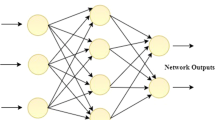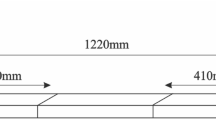Abstract
Visible and near-infrared (VIS–NIR) spectroscopy was used for classifying and predicting the properties of thermally modified Western hemlock wood. The specimens were treated at 170 °C, 212 °C, and 230 °C. The dimensional reduction was performed using linear discriminant analysis, and the resulted dataset was used for wood classification using the support vector machines and the linear vector quantization neural network. The VIS–NIR dataset was also used to predict the wood moisture content, swelling coefficient, water absorption, density, dynamic modulus of elasticity, and hardness. The “adaptive neuro-fuzzy inference system” (ANFIS), “Group Method of Data Handling” (GMDH), and “multilayer perceptron” (MLP) neural networks were employed for predicting the wood properties. It was shown that regardless of the type of the neural network, NIR dataset provided a robust model with 100% classification accuracy, which can be implemented in industrial scale for in-line timber quality control. The results indicated that the ANFIS and GMDH neural network showed higher performance than the MLP model for predicting the wood properties. While the VIS–NIR data resulted in a promising accuracy for predicting the wood moisture content and dimensional stability parameters, it did not seem suitable for the prediction of wood density and its mechanical properties. The performance of the VIS–NIR spectroscopy method for classification and characterization of heat-treated timber was compared with that obtained using the color measurement and the stress wave method detected by the acoustic emission sensor.



Similar content being viewed by others
Abbreviations
- EMC:
-
Equilibrium moisture content (%)
- H :
-
Relative humidity (%)
- H l :
-
Longitudinal hardness
- H s :
-
Side hardness
- MOE:
-
Modulus of elasticity
- MOEdyn :
-
Dynamic modulus of elasticity
- MOR:
-
Modulus of rupture
- V :
-
Stress wave velocity
- V 0 :
-
Oven-dried volume
- V s :
-
Volume after wetting with water
- VSC:
-
Volumetric swelling coefficient (%)
- W 0 :
-
Oven-dry weight
- W s :
-
Weight after soaking in water
- WA:
-
Water absorption (%)
- ρ :
-
Wood density (kg/m3)
- AE:
-
Acoustic emission
- ANFIS:
-
Adaptive neuro-fuzzy inference system
- ANN:
-
Artificial neural network
- FCM:
-
Fuzzy C-mean
- FIS:
-
Fuzzy inference system
- GMDH:
-
Group method of data handling
- LDA:
-
Linear discriminant analysis
- LVQ:
-
Linear vector quantization
- MLP:
-
Multilayer perceptron
- MSE:
-
Mean square error
- NDE:
-
Non-destructive evaluation
- NIR:
-
Near-infrared
- VIS–NIR:
-
Visible and Near-infrared
- NN:
-
Neural network
- PLS:
-
Partial least-squares
- SMO:
-
Sequential minimal optimization
- SVM:
-
Support vector machines
- TM:
-
Thermal modification
- TMT:
-
Thermally treated timber
References
Bächle H, Zimmer B, Windeisen E, Wegener G (2010) Evaluation of thermally modified beech and spruce wood and their properties by FT-NIR spectroscopy. Wood Sci Technol 44(3):421–433
Bächle H, Zimmer B, Wegener G (2012) Classification of thermally modified wood by FT-NIR spectroscopy and SIMCA. Wood Sci Technol 46(6):1181–1192
Bekhta P, Niemz P (2003) Effect of high temperature on the change in color, dimensional stability and mechanical properties of spruce wood. Holzforschung 57(5):539–546
Brischke C, Welzbacher CR, Brandt K, Rapp AO (2007) Quality control of thermally modified timber: interrelationship between heat treatment intensities and CIE L* a* b* color data on homogenized wood samples. Holzforschung 61(1):19–22
Esteves B, Pereira H (2008) Quality assessment of heat-treated wood by NIR spectroscopy. Holz Roh Werkst 66:323–332
Esteves B, Pereira H (2009) Wood modification by heat treatment: a review. BioResources 4(1):370–404
Esteves B, Marques AV, Domingos I, Pereira H (2008) Heat-induced colour changes of pine (Pinus pinaster) and eucalypt (Eucalyptus globulus) wood. Wood Sci Technol 42(5):369–384
Fan RE, Chen PH, Lin CJ (2005) Working set selection using second order information for training support vector machines. J Mach Learn Res 6:1889–1918
González-Peña MM, Hale MD (2009a) Colour in thermally modified wood of beech, Norway spruce and Scots pine. Part 1: colour evolution and colour changes. Holzforschung 63(4):385–393
González-Peña MM, Hale MD (2009b) Colour in thermally modified wood of beech, Norway spruce and Scots pine. Part 2: property predictions from colour changes. Holzforschung 63(4):394–401
Hill CA (2007) Wood modification: chemical, thermal and other processes, vol 5. Wiley series in renewable resources. Wiley, London, pp 99–127 (ISBN: 0-470-02172-1)
Hinterstoisser B, Schwanninger M, Stefke B, Stingl R, Patzelt M (2003) Surface analyses of chemically and thermally modified wood by FT-NIR. In: Acker VJ, Hill C (eds) The 1st European conference on wood modification. Proceeding of the first international conference of the European society for wood mechanics, pp 15–20
Johansson D (2008) Heat treatment of solid wood: effects on absorption, strength and colour. Doctoral dissertation, Luleå tekniska universitet
Johansson D, Morén T (2006) The potential of colour measurement for strength prediction of thermally treated wood. Holz Roh- Werkst 64(2):104–110
Kačíková D, Kačík F, Čabalová I, Ďurkovič J (2013) Effects of thermal treatment on chemical, mechanical and colour traits in Norway spruce wood. Bioresour Technol 144:669–674
Lengowski EC, de Muñiz GIB, Klock U, Nisgoski S (2018) Potential use of nir and visible spectroscopy to analyze chemical properties of thermally treated wood, Maderas. Ciencia y Tecnología 20(4). Retrieved from http://revistas.ubiobio.cl/index.php/MCT/article/view/3228
Liang H, Zhang M, Gao C, Zhao Y (2018) Non-destructive methodology to determine modulus of elasticity in static bending of Quercus mongolica using near-infrared spectroscopy. Sensors 18(6):1963
Mehrotra R, Singh P, Kandpal H (2010) Near infrared spectroscopic investigation of the thermal degradation of wood. Thermochim Acta 507:60–65
Mitsui K, Inagaki T, Tsuchikawa S (2007) Monitoring of hydroxyl groups in wood during heat treatment using NIR spectroscopy. Biomacromol 9(1):286–288
Nasir V, Cool J (2018) A review on wood machining: characterization, optimization, and monitoring of the sawing process. Wood Mater Sci Eng. https://doi.org/10.1080/17480272.2018.1465465
Nasir V, Nourian S, Avramidis S, Cool J (2019a) Classification of thermally treated wood using machine learning techniques. Wood Sci Technol 53(1):275–288
Nasir V, Nourian S, Avramidis S, Cool J (2019b) Stress wave evaluation by accelerometer and acoustic emission sensor for thermally modified wood classification using three types of neural networks. Eur J Wood Prod 77(1):45–55. https://doi.org/10.1007/s00107-018-1373-1
Nasir V, Nourian S, Avramidis S, Cool J (2019c) Stress wave evaluation for predicting the properties of thermally modified wood using neuro-fuzzy and neural network modeling. Holzforschung. https://doi.org/10.1515/hf-2018-0289
Nasir V, Cool J, Sassani F (2019d) Acoustic emission monitoring of sawing process: artificial intelligence approach for optimal sensory feature selection. Int J Adv Manuf Technol 102(9–12):4179–4197. https://doi.org/10.1007/s00170-019-03526-3
Nasir V, Nourian S, Avramidis S, Cool J (2019e) Prediction of physical and mechanical properties of thermally modified wood based on color change evaluated by means of ‘group method of data handling’ (GMDH) neural network. Holzforschung 73(4):381–392. https://doi.org/10.1515/hf-2018-0146
Platt JC (1999) Fast training of support vector machines using sequential minimal optimization. In: Scholkopf B, Burges CJC, Smola AJ, Press MIT (eds) Advances in kernel methods—support vector learning. MIT Press, Cambridge, pp 185–208
Riggio M, Sandak J, Sandak A, Pauliny D, Babiński L (2014) Analysis and prediction of selected mechanical/dynamic properties of wood after short and long-term waterlogging. Constr Build Mater 68:444–454
Sandak A, Sandak J, Riggio M (2015) Estimation of physical and mechanical properties of timber members in service by means of infrared spectroscopy. Constr Build Mater 101:1197–1205
Sandak J, Sandak A, Meder R (2016) Assessing trees, wood and derived products with near infrared spectroscopy: hints and tips. J Near Infrared Spectrosc 24(6):485–505
Sandberg D, Kutnar A, Mantanis G (2017) Wood modification technologies: a review. IForest 10(6):895
Schnabel T, Zimmer B, Petutschnigg AJ, Schönberger S (2007) An approach to classify thermally modified hardwoods by color. Forest Prod J 57(9):105
Schwanninger M, Hinterstoisser B, Gierlinger N, Wimmer R, Hanger J (2004) Application of Fourier transform near infrared spectroscopy (FT-NIR) to thermally modified wood. Holz Roh- Werkst 62(6):483–485
Schwanninger M, Rodrigues JC, Fackler K (2011) A review of band assignments in near infrared spectra of wood and wood components. J Near Infrared Spectrosc 19(5):287–308
Todorović N, Popović Z, Milić G (2015) Estimation of quality of thermally modified beech wood with red heartwood by FT-NIR spectroscopy. Wood Sci Technol 49(3):527–549
Tsuchikawa S, Kobori H (2015) A review of recent application of near infrared spectroscopy to wood science and technology. J Wood Sci 61(3):213
Tumen I, Aydemir D, Gunduz G, Uner B, Cetin H (2010) Changes in the chemical structure of thermally treated wood. BioResources 5(3):1936–1944
Watanabe K, Hart F, Mansfield SD, Avramidis S (2010) Detection of wet-pockets on the surface of Tsuga heterophylla (Raf.) Sarg. by near infrared (NIR) spectroscopy. Holzforschung 64(1):55–60
Watanabe K, Mansfield SD, Avramidis S (2012) Wet-pocket classification in Abies lasiocarpa using spectroscopy in the visible and near infrared range. Eur J Wood Prod 70(1–3):61–67
Willems W, Lykidis C, Altgen M, Clauder L (2015) Quality control methods for thermally modified wood. Holzforschung 69(7):875–884
Yang Z, Liu Y, Pang X, Li K (2015) Preliminary investigation into the identification of wood species from different locations by near infrared spectroscopy. BioResources 10(4):8505–8517
Zanuncio AJV, Hein PRG, Carvalho AG, Rocha MFV, Carneiro ACO (2018) Determination of heat treated eucalyptus and pinus wood properties using NIR spectroscopy. J Trop For Sci 30(1):117–125
Author information
Authors and Affiliations
Corresponding author
Additional information
Publisher's Note
Springer Nature remains neutral with regard to jurisdictional claims in published maps and institutional affiliations.
Rights and permissions
About this article
Cite this article
Nasir, V., Nourian, S., Zhou, Z. et al. Classification and characterization of thermally modified timber using visible and near-infrared spectroscopy and artificial neural networks: a comparative study on the performance of different NDE methods and ANNs. Wood Sci Technol 53, 1093–1109 (2019). https://doi.org/10.1007/s00226-019-01120-0
Received:
Published:
Issue Date:
DOI: https://doi.org/10.1007/s00226-019-01120-0




